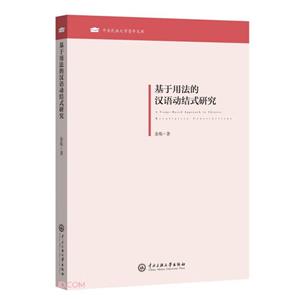-
>
心理学经典文丛:女性心理学
-
>
贫困一代:被社会囚禁的年轻人
-
>
乌合之众:大众心理研究(英汉双语修订版)(套装共2册)
-
>
始于极限:女性主义往复书简
-
>
融合文化(新媒体和旧媒体的冲突地带)/文化和传播译丛
-
>
看不见的女性
-
>
县乡中国:县域治理现代化
基于用法的汉语动结式研究/中央民族大学青年文库 版权信息
- ISBN:9787566021069
- 条形码:9787566021069 ; 978-7-5660-2106-9
- 装帧:一般胶版纸
- 册数:暂无
- 重量:暂无
- 所属分类:>
基于用法的汉语动结式研究/中央民族大学青年文库 内容简介
本书对汉语动结式进行了基于用法的研究,包括语料库分析和可接受度调查。 首先对于汉语动结式的语料库研究,基于“现代汉语述补结构用法数据库”(the Online Database on Verb-Resultative Constructions in Contemporary Chinese ,ODVRC)中列出的结果XP,从兰卡斯特汉语语料库(the Lancaster Corpus of Mandarin Chinese,LCMC)收集语料,提出了两个测试来检验汉语结果XP,区分了汉语的边界和原型动结式。本书对汉语动结式的类型和个数频次进行了描述性分析,并讨论了汉语动结式的类型学分类。 基于语料库的例句,本书考查结构为[主语+动词+(宾语)+结果XP]动结式的可接受度,通过问卷调查进行可接受度研究。问卷还调查了“把字句+动结式”的可接受度。调查结果显示,“把+动结式”的可接受度形成一个连续统,尤其“主语指向动结式”是否加“把”有显著差异。“把+动结式”的可接受度取决于句子表达的语义及物性的程度。本书提出的认知解释为,句子表达的高及物性与“把”作为高及物性的标记功能一致。这也支持了学界对“把”字句功能的讨论,即将其视为高及物性的标志,而不是表达处置或致使关系。
基于用法的汉语动结式研究/中央民族大学青年文库 目录
1.1 Preliminaries
1.1.1 The resultative construction in Mandarin Chinese
1.1.2 The 把 ba-construction
1.1.3 The acceptability of resultative constructions in Mandarin
1.2 Theoretical framework
1.3 Structure of the book
Chapter 2 Literature review
2.1 Introduction and structure of the chapter
2.2 Resultative constructions
2.2.1 Formal approach
2.2.2 Functional-cognitive analysis
2.2.3 General discussion ofresultatives
2.3 The 把 ba-construction
2.3.1 Syntactic analysis
2.3.2 Semantic analysis
2.4 Combinations of resultative constructions and other constructions
2.5 Corpus studies on Chinese resultatives
2.6 Concluding remarks
Chapter 3 Methodology
3.1 Introduction
3.2 Corpus-based approach
3.3 Acceptability judgement approach
3.3.1 Grammaticality verus acceptability
3.3.2 Traditional ways of making acceptability judgements
3.3.3 Magnitude estimation
3.3.4 Questionnaire survey
3.4 Concluding remarks
Chapter 4 A corpus study of Chinese resultatives
4.1 Introduction
4.1.1 Motivation for the corpus analysis of Chinese resultatives
4.1.2 Structure of the chapter
4.2 Methodology
4.2.1 Corpus
4.2.2 Two tests for the identification of Chinese resultatives
4.2.3 Criteria for corpus analysis: classifications of resultatives...
4.3 A corpus study of Chinese resultatives: results
4.3.1 Preliminaries
4.3.2 Classification of Chinese resultatives and more dimensions
4.3.3 A general corpus analysis of Chinese resultatives
4.4 A corpus study of Chinese resultatives: discussion
4.4.1 Chinese resultatives: a typological point of view
4.4.2 Chinese marginal and prototypical resultatives
4.5 Concluding remarks
Chapter 5 把 ba + subject/agent-oriented resultatives:acceptability judgements
5.1 Introduction
5.1.1 Chinese subject-oriented resultative constructions
5.1.2 把 ba + subject/agent-oriented resultatives in Chinese
5.1.3 Structure of the chapter
5.2 The 把 ba-construction: more about high semantic transitivity
5.3 Methodology
5.3.1 Corpus
5.3.2 Questionnaire survey
5.4 The questionnaire survey: results and discussion
5.4.1 Resultatives with and without 把 ba
5.4.2 把 ba + resultatives with and without 终于 zhongyu 'finally'.
5.5 Further implications
5.5.1 Subject/agent-oriented resultatives with postverbal NP
5.5.2 The acceptability of 把 ba + subject-oriented resultatives
5.6 Concluding remarks
Chapter 6 The acceptability of 把 ba + object-oriented resultatives
6.1 Introduction
6.1.1 把 ba + object-oriented resultatives in Chinese
6.1.2 Methodology
6.1.3 Structure of the chapter
6.2 The acceptability of object-oriented resultatives with and without 把 ba
6.2.1 Results
6.2.2 Discussion
6.3 The acceptability of 把 ba + subject-oriented resultatives
6.4 The acceptability of 把 ba + subject-/object-oriented resultatives
6.4.1 Results
6.4.2 Discussion
6.5 Further implications
6.5.1 The acceptability of subject-/object-oriented resultatives
6.5.2 The acceptability of 把 ba+subj ect-/object-oriented resultatives
6.5.3 Subject-oriented resultatives vs. object-oriented resultatives:唱-红 chang-hong 'sing-popular'.
6.6 Concluding remarks
Chapter 7 Conclusion
7.1 Summary
7.2 Contribution
7.3 Limitations
7.4 Suggestions for further work
References
Appendix A: Chinese Questionnaire surveys of acceptability of Chinese resultatives
Appendix B: English translation of questionnaire surveys of acceptability of Chinese resultatives
基于用法的汉语动结式研究/中央民族大学青年文库 作者简介
余烁,女,中央民族大学国际教育学院讲师,硕士生导师。2010年获英国伦敦大学学院语言学硕士学位,2019年获英国兰卡斯特大学语言学博士学位。曾应邀赴美国、法国、意大利、巴西、英国等大学和研究机构参加国际会议并发言,主要研究兴趣包括认知语言学、构式语法、语料库研究、二语习得等。
-
汉字有话说-说出中华文化原初样式
¥24.4¥58 -
中华经典指掌文库王昌龄诗集/中华经典指掌文库
¥15¥16 -
汉字王国
¥23.5¥46 -
真的不用读完一本书
¥11.2¥35 -
小书馆:古汉语入门
¥26.9¥39 -
语病百讲
¥9.9¥29
















